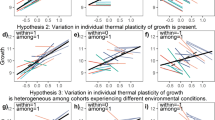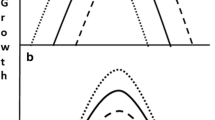Abstract
Controlled environment experiments were carried out to investigate thermal influences and population differences on growth of wild-caught juvenile Atlantic cod Gadus morhua L. from two regions of differing thermal regime off Scotland; the Clyde Sea on the west coast and St Andrews Bay on the east coast. Cod from the Clyde demonstrated significantly higher growth rates than cod from St Andrews. In both populations the growth rate was greater at 12°C than at 8°C. These population and temperature effects act to reinforce one another and it could therefore be predicted that the growth differences between the two areas in the wild should be even more pronounced. The results are consistent with the suggestion that cod may be locally adapted to their thermal environment.



Similar content being viewed by others
References
Berven KA, Gill DE, Smith-Gill SJ (1979) Countergradient selection in the green frog, Rana clavitans. Evolution 33:609–623
Billerbeck JM, Orti G, Conover DO (1997) Latitudinal variation in vertebral number has a genetic basis in the Atlantic silverside, Menidia menidia. Can J Fish Aquat Sci 54:1796–1801
Biswas AK, Takeuchi T (2003) Effects of photoperiod and feeding interval on food intake and growth rate of Nile tilapia Oreochromis niloticus L. Fisheries Sci 69:1010–1016
Björnsson B, Steinarsson A (2002) The food-unlimited growth rate of Atlantic cod (Gadus morhua). Can J Fish Aquat Sci 59:494–502
Brander KM (1994) Spawning and life history information for North Atlantic cod stocks. ICES Coop Res Rep 205:64–83
Brander KM (1995) The effect of temperature on growth of Atlantic cod (Gadus morhua L.). ICES J Mar Sci 52:1–10
Brett JR (1979) Environmental factors and growth. In: Hoar WS, Randall DJ, Brett JR (eds) Fish physiology. Academic, New York, pp 599–675
Case RAJ, Hutchinson WF, Hauser L, Oosterhout CV, Carvalho GR (2005) Macro- and micro-geographic variation in pantophysin (PanI) allele frequencies in NE Atlantic cod Gadus morhua. Mar Ecol Prog Ser 301:267–278
Case RAJ, Hutchinson WF, Hauser L, Buehler V, Clemmesen C, Dahle G, Kjesbu OS et al (2006) Association between growth and Pan I* genes within Atlantic cod full-siblings families. Trans Am Fish Soc 135:241–250
Clemmesen C, Bühler V, Carvalho G, Case R, Evans G, Hauser L, Hutchinson WF, Kjesbu OS, Mempel H, Moksness E, Otteraa H, Paulsen H, Thorsen A, Svaasand T (2003) Variability in condition and growth of Atlantic cod larvae and juveniles reared in mesocosms: environmental and maternal effects. J Fish Biol 62:706–723
Conover DO (1998) Local adaptation in marine fishes: evidence and implications for stock enhancement. Bull Mar Sci 62:477–493
Conover DO, Present TMC (1990) Countergradient variation in growth rate: compensation for length of the growing season among Atlantic silversides from different latitudes. Oecologia 83:316–324
Conover DO, Schultz ET (1995) Phenotypic similarity and the evolutionary significance of countergradient variation. TREE 10:248–252
Conover DO, Clarke LM, Munch SB, Wagner GN (2006) Spatial and temporal divergence in marine fishes and the implications for conservation. J Fish Biol 69(Suppl C):21–47
Dutil J-D, Jabouin C, Larocque R, Desrosiers G, Blier PU (2008) Atlantic cod (Gadus morhua) from cold and warm environments differ in their maximum growth capacity at low temperatures. Can J Fish Aquat Sci 65:2579–2591
Folkvord A (1991) Growth and cannibalism of cod juveniles (Gadus morhua): effects of feed type, starvation and fish size. Aquaculture 97:41–59
Galley EA, Wright PJ, Gibb FM (2006) Combined methods of otolith shape analysis improve identification of spawning areas of Atlantic cod. ICES J Mar Sci 63:1710–1717
Gibb FM, Gibb IM, Wright PJ (2007) Isolation of Atlantic cod (Gadus morhua) nursery areas. Mar Biol 151:1185–1194
Gjerde B, Terjesen BF, Barr Y, Lein I, Thorland I (2004) Genetic variation for juvenile growth and survival in Atlantic cod (Gadus morhua). Aquaculture 236:167–177
Hauser L, Carvalho GR (2008) Paradigm shifts in marine fisheries genetics: ugly hypotheses slain by beautiful facts. Fish and Fish 9:333–362
Heath MR, Kunzlik PA, Gallego A, Holmes SJ, Wright PJ (2008) A model of meta-population dynamics for northern European cod - the dynamic consequences of natal fidelity. Fish Res 93:92–116
Hughes SL (2004) The Scottish ocean climate status report 2002 and 2003. Fisheries Research Services, Aberdeen
Hutchings JA (2002) Life histories of fish. In: Hart PJB, Reynolds JD (eds) Handbook of fish biology and fisheries. Blackwell Publishing, Oxford, pp 149–167
Hutchings JA, Swain DP, Puvanendran V, Rowe S, Brown JA (2006) Genetic differences in life history reaction norms among populations of Atlantic cod (Gadus morhua). J Fish Biol 69(suppl C):233
Hutchinson WF, Carvalho GR, Rogers SI (2001) Marked genetic structuring in localised spawning populations of cod Gadus morhua in the North Sea and adjoining waters, as revealed by microsatellites. Mar Ecol Prog Ser 223:251–260
Imsland AK, Jónsdóttir ODB (2002) Is there a genetic basis to growth in Atlantic cod? Fish Fish 3:36–52
Imsland AK, Sunde LM, Folkvord A, Stefansson SO (1996) The interaction of temperature and size on growth of juvenile turbot (Scophthalmus maximus). J Fish Biol 49:926–940
Imsland AK, Foss A, Naevdal G, Stefansson SO (2001) Selection or adaptation: differences in growth performance of juvenile turbot (Scophthalmus maximus Rafinesque) from two close-by localities off Norway. Sarsia 86:43–51
Imsland AK, Foss A, Nævdal G, Johansen T, Folkvord A, Stefansson SO, Jonassen TM (2004) Variations in growth in haemoglobin genotypes of Atlantic cod. Fish Physiol Biochem 30:47–55
Jobling M (1985) Growth. In: Tytler P, Calow P (eds) Fish energetics: new perspectives. Croom Helm, London, pp 213–229
Jobling M (1988) A review of the physiological and nutritional energetics of cod, Gadus morhua L., with particular reference to growth under farmed conditions. Aquaculture 70:1–19
Johnston IA (1993) Temperature influences muscle differentiation and the relative timing of organogenesis in herring (Clupea harengus) larvae. Mar Biol 116:363–379
Johnston IA, Cole NJ, Abercromby M, Vieira VLA (1998) Embryonic temperature modulates muscle growth characteristics in larval and juvenile herring. Journal Exp Biol 201:623–646
Jonassen TM, Imsland AK, Stefansson SO (1999) The interaction of temperature and fish size on growth of juvenile Atlantic halibut. J Fish Biol 54:556–572
Kadri S, Metcalfe NG, Huntingford FA, Thorpe JE (1997) Daily feeding rhythms in Atlantic salmon I: feeding and aggression in parr under ambient environmental conditions. J Fish Biol 50:267–272
Koskela J, Pirhonen L, Jobling M (1997) Feed intake, growth rate and body composition of juvenile Baltic salmon exposed to different constant temperatures. Aquacult Int 5:351–360
Kjesbu OS (1989) The spawning activity of cod, Gadus morhua L. J Fish Biol 34:195–206
Lambert Y, Dutil JD (2001) Food intake and growth of adult Atlantic cod (Gadus morhua L.) reared under different conditions of stocking density, feeding frequency and size-grading. Aquaculture 192:233–247
Law R (2000) Fishing, selection, and phenotypic evolution. ICES J Mar Sci 57:659–668
Levesque HM, Short C, Moon TW, Ballantyne JS, Driedzic WR (2005) Effects of seasonal temperature and photoperiod on Atlantic cod (Gadus morhua). I. Morphometric parameters and metabolites. Can J Fish Aquat Sci 62:2854–2863
Levins R (1968) Evolution in a changing environment. Princeton University Press, Princeton
Levins R (1969) Thermal acclimation and heat resistance in Drosophila species. Am Nat 103:483–499
Marcil J, Swain DA, Hutchings JA (2006) Countergradient variation in body shape between two populations of Atlantic cod (Gadus morhua). Proc R Soc B 273:217–223
Marteinsdottir G, Steinarsson A (1998) Maternal influence on the size and viability of Iceland cod (Gadus morhua L.) eggs and larvae. J Fish Biol 52:1241–1258
McCulloch CE, Searle SR (2000) Generalized, linear, and mixed models. Wiley, New York
Nævdal G, Folkvord A, Otterlei E, Thorkildsen S (1992) Growth rate related to genotype of 0-group cod at three environmental temperatures. Sarsia 77:71–73
Neat F, Righton D (2007) Warm water occupancy by North Sea cod. Proc R Soc B 274:789–798
Neat FC, Wright PJ, Zuur AF, Gibb IM, Gibb FM, Tulett D, Righton DA, Turner RJ (2006) Residency and depth movements of a coastal group of Atlantic cod (Gadus morhua L.). Mar Biol 148:643–654
Otterlei E, Nyhammer G, Folkvord A, Stefansson SO (1999) Temperature- and size-dependent growth of larval and early juvenile Atlantic cod (Gadus morhua): a comparative study of Norwegian coastal cod and northeast Arctic cod. Can J Fish Aquat Sci 56:2099–2111
Peck MA, Buckley LJ, Bengtson DA (2003) Energy losses due to routine and feeding metabolism in young-of-the-year juvenile Atlantic cod (Gadus morhua). Can J Fish Aquat Sci 60:929–937
Perutz M (2007) Population variation in the life history traits and thermal responses of Atlantic cod, Gadus morhua L., PhD thesis, University of Glasgow, Glasgow
Purchase CF, Brown JA (2000) Interpopulation differences in growth rates and food conversion efficiencies of young Grand Banks and Gulf of Maine Atlantic cod (Gadus morhua). Can J Fish Aquat Sci 57:2223–2229
Salvanes AGV, Skjaeraasen JE, Nilsen T (2004) Sub-populations of coastal cod with different behaviour and life-history strategies. Mar Ecol Prog Ser 267:241–251
Sartoris FJ, Bock S, Serendero I, Lannig G, Pörtner HO (2003) Temperature-dependent changes in energy metabolism, intracellular pH and blood oxygen tension in the Atlantic cod. J Fish Biol 62:1239–1253
Slesser G, Turrell WR (2005) Annual cycles of physical, chemical and biological parameters in Scottish waters (2005 update). Fisheries Research Services Internal Report, 19/05
Wright PJ, Gibb FM (2005) Selection for birth date in North Sea haddock and its relation to maternal age. J Anim Ecol 74:303–312
Wright PJ, Neat FC, Gibb FM, Gibb IM, Thordarson H (2006a) Evidence for metapopulation structuring in cod from the west of Scotland and North Sea. J Fish Biol 69(suppl C):1–19
Wright PJ, Galley E, Gibb IM, Neat FC (2006b) Fidelity of adult cod to spawning grounds in Scottish waters. Fish Res 77:148–158
Yoneda M, Wright PJ (2005) Effects of varying temperature and food availability on growth and reproduction in first-time spawning female Atlantic cod. J Fish Biol 67:1225–1241
Acknowledgements
We are grateful to I. Gibb, the crew of the Fisheries Research Vessel Clupea and Millport Marine Biological Station for collection of the fish, to B. Williamson, P. Gibson and M. Norris for technical assistance, husbandry and assistance in sampling of the fish, and to C. Millar for statistical advice. Financial support was given by a PhD studentship 2004 from the Fisheries Society of the British Isles. The work was carried out under a Scottish Executive contract MF0756. Experiments were authorised under a United Kingdom Home Office License.
Author information
Authors and Affiliations
Corresponding author
Rights and permissions
About this article
Cite this article
Harrald, M., Neat, F.C., Wright, P.J. et al. Population variation in thermal growth responses of juvenile Atlantic cod (Gadus morhua L.). Environ Biol Fish 87, 187–194 (2010). https://doi.org/10.1007/s10641-010-9586-0
Received:
Accepted:
Published:
Issue Date:
DOI: https://doi.org/10.1007/s10641-010-9586-0




